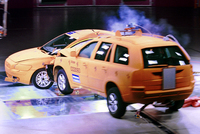2007 Volvo XC90 Rated Top Safety Pick by IIHS - VIDEO
ENHANCED STORY
Highest safety award by the Insurance Institute for Highway Safety
CLICK HERE
to watch video of the XC90 being crash tested at the factory.
IRVINE, CA - November 23, 2006: The Volvo SUV was among 13 vehicles earning TOP SAFETY PICK awards for
2007 announced by the Insurance Institute for Highway Safety (IIHS).

|
This
award recognizes vehicles that do the best job of protecting people in
front, side, and rear crashes based on ratings in IIHS tests. "Our crash
tests cover the most common kinds of real-world collisions," says Institute
president Adrian Lund. "Designating TOP SAFETY PICK winners based on the
tests makes it easier for consumers to identify vehicles that afford the
best overall protection without sifting through multiple sets of
comparative test results." A new requirement for 2007 is that the winning
vehicles must offer electronic stability control, or ESC. This addition is
based on Institute research indicating that ESC significantly reduces crash
risk, especially the risk of fatal single-vehicle crashes, by helping
drivers maintain control of their vehicles during emergency maneuvers. It
is notable that the Volvo XC90's Roll Stability Control (RSC) was an
industry first.

|
"Integrated safety technology has set the XC90 apart since its
introduction, and it's part of Volvo DNA to focus of real-world safety,"
says Anne Bélec, president & CEO, Volvo Cars of North America. "An award
like this validates Volvo's commitment, and explains why customers have
made the XC90 the best-selling European SUV in the United States."
The IIHS rates vehicles good, acceptable, marginal, or poor based on
performance in high-speed front and side crash tests plus evaluations of
seat/head restraints for protection against neck injuries in rear impacts.
The first requirement for a vehicle to become a TOP SAFETY PICK is to earn
good ratings in all three Institute tests. The Volvo XC90 achieved "Good"
in each of the three crash tests.
CLICK HERE
to running footage of the XC90.
SUVs weren't eligible to win in 2006 because the Institute hadn't
evaluated the side crashworthiness of many of them. Now more SUVs have been
rated, and 2007 winners reflect the safety improvements manufacturers have
been making to these vehicles.
The criteria for selecting winners included:

|
The Institute's frontal
crashworthiness evaluations are based on results of frontal offset crash
tests at 40 mph. Each vehicle's overall evaluation is based on measurements
of intrusion into the occupant compartment, injury measures from a Hybrid
III dummy in the driver seat, and analysis of slow-motion film to assess
how well the restraint system controlled dummy movement during the test.
Each vehicle's overall side evaluation is based on performance in a crash
test in which the side of the vehicle is struck by a barrier moving at 31
mph that represents the front end of a pickup or SUV. Ratings reflect
injury measures recorded on two instrument-equipped dummies, assessment of
head protection countermeasures, and the vehicle's structural performance
during the impact. Injury measures obtained from the two dummies, one in
the driver seat and the other in the back seat behind the driver, are used
to determine the likelihood that a driver and/or passenger in a real-world
crash would have sustained serious injury. The movements and contacts of
the dummies' heads during the crash also are evaluated. Structural
performance is based on measurements indicating the amount of B-pillar
intrusion into the occupant compartment.
Rear crash protection is rated according to a two-step procedure.
Starting points for the ratings are measurements of head restraint geometry
— the height of a restraint and its horizontal distance behind the
back of the head of an average-size man. Seats with good or acceptable
restraint geometry are tested dynamically using a dummy that measures
forces on the neck. This test simulates a collision in which a stationary
vehicle is struck in the rear at 20 mph. Seats without good or acceptable
geometry are rated poor overall because they can't be positioned to protect
many people.






